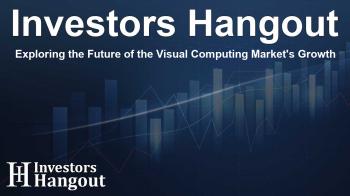Exploring the Future of the Visual Computing Market's Growth

Visual Computing Market Size & Growth Insights
The visual computing market is experiencing remarkable growth, anticipated to escalate from USD 38.53 billion in 2023 to an impressive USD 245.79 billion by 2032. This growth trajectory represents a compound annual growth rate (CAGR) of 22.89% over the upcoming years.
Transforming Industries with AI and Real-Time Rendering
This transformation can be largely attributed to significant advancements in technologies such as artificial intelligence (AI), edge and cloud computing, real-time rendering, and OLED displays. These technologies are revolutionizing the way various sectors operate. Industries including gaming, media and entertainment, automotive, and healthcare are now leveraging high-performance computing, AI-enhanced visuals, and intelligent processing for real-time image and video analysis.
The Growing U.S. Market for Visual Computing
The U.S. visual computing sector alone is valued at approximately USD 10.84 billion in 2023, with projections indicating a growth rate of 22.70%. This growth showcases the increasing adoption of AI within visual computation, enhancing user experiences across various platforms.
Key Players Shaping the Visual Computing Landscape
Leading the charge in this booming sector are notable players like SenseTime with their innovative SenseFoundry, Megvii’s Face++, and Airobotics, which provides automated industrial drones. Each of these companies contributes to the visual computing market through advanced solutions that integrate AI and visualization technologies.
Market Scope and Segmentation Insights
The visual computing report delves into various attributes including market size, competitive landscape, and regional analysis. It highlights crucial drivers such as the rapid adoption of high-performance graphics computing across industries.
Driving Forces in Visual Computing
Several factors are propelling growth within the visual computing market. Innovations in high-performance computing (HPC), gaming graphics, and augmented/virtual reality (AR/VR) applications are transforming how industries utilize visual computing.
Innovations in Components and Display Platforms
In 2023, the hardware segment played a pivotal role in capturing 60.7% of the visual computing market share, driven by increasing demand for high-performance GPUs. As the demand for immersive experiences rises, sectors like automotive and healthcare increasingly rely on high-end hardware to facilitate real-time simulations and transformative AI applications.
Industry Application Insights
Gaming, for instance, has taken the lead in the visual computing market, accounting for a considerable 31.5% share. This is fueled by the need for high-performance graphics and real-time interactions that keep players engaged.
Healthcare’s Evolving Role
Moreover, the healthcare industry is set to experience the highest CAGR as AI continues to innovate 3D medical imaging and diagnostics while enhancing robotic-assisted surgeries. Applications in telemedicine and predictive analytics are expanding, positioning visual computing as essential in modern healthcare improvement strategies.
Regional Insights: North America vs. Asia Pacific
Regionally, North America held a considerable 36.7% of the visual computing market share in 2023 due to its advanced technological ecosystem. Companies like NVIDIA and AMD lead the innovation in AI-powered GPUs and real-time rendering solutions.
Rising Investments in the Asia Pacific Region
On the other hand, the Asia Pacific market is projected to grow at the highest rate, supported by significant investments in AI technologies, gaming, and smart infrastructure. Rapid advancements in countries such as China and Japan demonstrate the potential for innovation in gaming and AI applications.
Recent Developments in Visual Computing
Notable advancements include innovative applications like REWE’s AI-powered stores, showcasing the practical use of visual computing technology in real-world settings.
Frequently Asked Questions
What is the current value of the visual computing market?
The visual computing market is valued at approximately USD 38.53 billion in 2023.
What is the expected market size by 2032?
It is expected that the market will reach USD 245.79 billion by 2032.
Which industry currently leads the visual computing market?
The gaming industry is leading the visual computing market with a significant market share driven by gaming innovations.
What are the main drivers of market growth?
Key drivers include advances in AI, real-time rendering, and increased demand for high-performance graphics across various sectors.
How does the Asia Pacific region contribute to the market?
The Asia Pacific region shows significant potential for growth due to increased investments in AI and gaming technologies.
About The Author
Contact Logan Wright privately here. Or send an email with ATTN: Logan Wright as the subject to contact@investorshangout.com.
About Investors Hangout
Investors Hangout is a leading online stock forum for financial discussion and learning, offering a wide range of free tools and resources. It draws in traders of all levels, who exchange market knowledge, investigate trading tactics, and keep an eye on industry developments in real time. Featuring financial articles, stock message boards, quotes, charts, company profiles, and live news updates. Through cooperative learning and a wealth of informational resources, it helps users from novices creating their first portfolios to experts honing their techniques. Join Investors Hangout today: https://investorshangout.com/
The content of this article is based on factual, publicly available information and does not represent legal, financial, or investment advice. Investors Hangout does not offer financial advice, and the author is not a licensed financial advisor. Consult a qualified advisor before making any financial or investment decisions based on this article. This article should not be considered advice to purchase, sell, or hold any securities or other investments. If any of the material provided here is inaccurate, please contact us for corrections.

